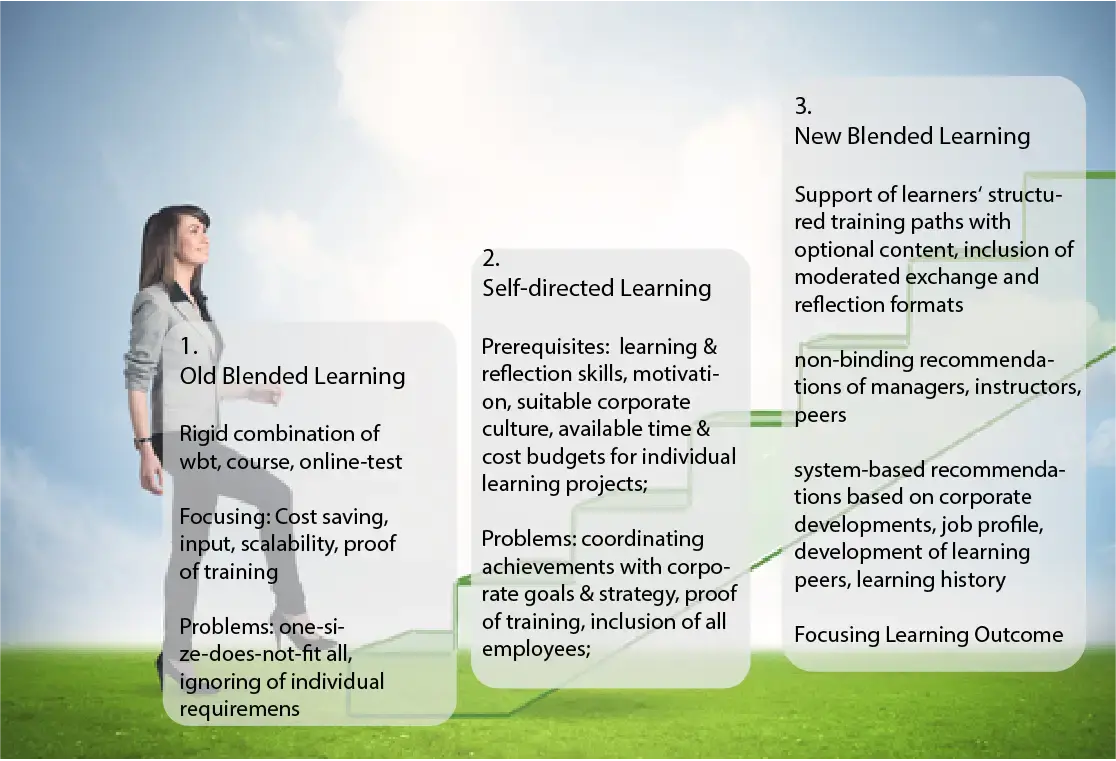Blended Learning is back
Blended Learning is celebrating a comeback. After the eLearning hype in the 90 and the following disillusionment, Blended Learning has matured to a powerful concept, due to its flexibility.
The versatile combination of media, virtual and hybrid exchange formats may now be combined with various structural elements, which are integrable in the learning arrangements, training paths or serve as optional enhancements.
To employ the advantages of modern Blended Learning Concepts, modern Learning Management Systems, Learning Platforms and Learning Portals must be more versatile and flexible.
Origins of Blended Learning
Blended Learning in its prime has perceived as a rigid corset, featuring a WBT, a classroom training and a test in a fixed order. The biggest advantage of Blended Learning was seen as saving cost by unlimited knowledge transfer at a fixed cost. This proved not entirely successful. The implementation of eLearning systems at the time was expensive and often a tedious experience, why the anticipated cost effect was not realized.
Also, the learners' perspective such as initial knowledge, individual and actual learning requirements, was basically ignored. This affected the motivation and resulted in a low acceptance of eLearning systems in general. Test results and proof of participation could be documented, but sustainable learning results were rare. (Read more about learners motivation...)
Self-organized Learning
The resulting disillusionment leads to an undifferentiated rejection of eLearning as such. For a time, self-organized / self-directed learning scenarios were welcomed euphorically. Learning experience platforms and agile learning were advertised. In fact, hopes were too high, and implementation only proofed successful for some privileged positions, departments and sectors.
Prerequisite for self-managed learning is not only personal learning and reflection competencies. Lack of meta-cognitive competencies leads to a distorted self-assessment (Dunning Kruger Effect). The selected learning content might turn out to be to complex or to under-challenging and cause a denial of learning in general ("I already know everything", " it's all to complicated for me").
Self-organized learning within organizational context demands an appropriate learning culture. Also the tasks and job profile must favor acquisition of new knowledge and skills. Learning content must be relevant and applicable. Learning effort must offer definite advantages and added value. It is obvious, that in many commercial sectors, regulated industries and for workers on production lines self-organized learning cannot easily be implemented.
Click here to read more about self-directed learning in companies
New Blended Learning Management
New Blended Learning implies that academy of training centers combine various formats to a holistic learning arrangement. These may entail formal, individual, and collaborative elements which might be mandatory or an optional enhancement to the learner. Today the learning landscape of an enterprise is not limited to own learning content. Interfaces connect the offer of external learning platforms, offering access to a broader selection of standard content and inspiration - also for learning professionals.
New blended learning reflects various facets of knowledge in differing degrees of complexity and thus provide innovative learning contents. The combination of formal and self-organized learning concepts (e. g. driven by interest, an actual challenge, recommendation...) can anchor new information via multiple channels. Additional formats, for learning peers to exchange experience and discuss interpretations and use cases supports the ability to reflect and other key competencies.
 Steps to New Blended Learning
Steps to New Blended Learning
Unpopular at times but still relevant are mandatory trainings. Subjects like “accident avoidance” and "safety trainings" are important trainings for employees.
Not only legally binding, but also ethical and morally relevant are trainings concerning compliance and data protection, which should reflect the values of the corporation. Compared to standard WBTs blended learning concepts can upgrade on the acceptance as an individual relevance to the individual situation can be stressed.
Enabling sustainable learning implies focusing on learner's outcome (subject-oriented). Based on the individual prerequisites and working reality a structured learning arrangement is a mainly an enabling framework.
Optional (parts of) training programs are not only driven by content, but also connected to reflection and exchange formats in life, online or hybrid surroundings. Selecting appropriate training content can be assisted by course ratings (quality) on the learning platform, but also by recommendations of training staff, management and peers.
To offer well thought out learning arrangements requires professional concepts and appropriate learning technology.
Central Learning Technology
How can learning technology support the demands of modern blended learning concepts? Essential parts are a versatile learning management system with training portals.
A learning platform "only" presents the offer, whilst a learning management system (LMS) reflects the organizational framework.
Training portals limit the access to authorized groups and individuals, protect their personal data and use of the learning platform. Learning portals (=training portals) contain sets of functionalities supporting processes which might be specific to the respective organization.
LMS for Blended Learning Management
The learning management system is the central component to manage blended learning concepts. To publish training events, webinars, courses, learning units and workshops means transferring them or their respective meta-data to training catalogs and learning platforms. A visualization of related and connected components, optional and mandatory units as well as prerequisites for enrollment or participation is achieved by employing an integrated Curriculum Editor.
Learning Content
LMS must manage various learning formats and media. It is important to be able to integrate various products of different authoring tools within the learning landscape. These can be independent course events or might be integrated in miscellaneous blended learning concepts. Blended learning concepts may include optional and not binding learning aspects to highlight certain aspects or broaden the perspective.
The option to flexibly combine formats and learning units is essential to structured blended learning projects. It is sensible to arrange them in a certain order, if certain knowledge or skills are prerequisite to understanding more advanced or complex learning units. To enable participation also for those, who have not gone through the anticipated order from the scratch, you might want do reduces content to smaller units. Not only tests and simulations can proof fulfilled prerequisite entry levels. A modern learning management system does not only draw information from the learner's education history, but also from flexible qualification profiles.
 Trainingscatalogue
Trainingscatalogue
To suggest relevant yet non-binding learning content to learners, data such as various educational needs, interests, job profiles, meaningful career paths for individual employees, and their evaluations of various events are maintained.
Through anonymized data comparisons of similar profiles or company trends, an AI based Learning Experience Platform can provide personalized learning recommendations.
(Learn how to transform a high number of classic training programs to Blended Learning Paths.)
Process Support
Processes illustrate the parameters of the respective learning and corporate culture. To regulate access to internal learning programs by is a matter of corporate strategy. Approval processes might be necessary to protect competitive advantages, whilst other sources of knowledge may be accessed for any employee. An LMS should enable corporate learning strategists to assign respective processes in general, but also depending on target group and specific content types. and
The LMS must include a broad training administration, supporting not only communication and automated resource planning, but also manage a variety of back office tasks.
It is also a question of the organizational budgeting whether personnel development and corporate learning is allocated to a cost center or department or is calculated according to the individual job profile and future developments. LMS' must thus provide various invoicing and calculation options. Precise and meaningful reporting enables a solid basis. It supplies not only information concerning participants statistics and cost. Feedback from participants from training programs and education campaigns allows to draw conclusions concerning the quality of the delivered training services.
 Elements of successfull Blended Learning Concepts
Elements of successfull Blended Learning Concepts
Blended Learning is not a matter of just combining several media and learning formats.
Give learners support and guidance and help them to deepen their learning experience.
IT Integration
Learning Management Systems are no islands. Interfaces connect the system to external applications such as external learning platforms and enrich the internal data center by contributing to HR and finance information. Frequent synchronizing and interpretation of data supports viable decisions.
No matter if the learning landscape was implemented as SaaS, an external hosted solution or onSite (installed within the own server landscape), responsible system administrators must ensure, that implemented software is subject to their security requirements. Your LMS vendor should therefore be certified by ISO 9001 and 27001 standards.
Learning Portals safeguard Access and Content
Learning Portals safeguard the access to a learning platform. Learning Portals not only make sure personal data is protected, but also learning content, containing strategic information of competitive advantage e. g. production processes.
To avoid separate logins, you may want to employ a single-sign-on access (SSO) corresponding to your enterprise's IT-regulations. A SSO serves as a single point of entry for authorized target groups.
Staff, external maintenance, sales or service partners, managers or instructors may find their own set of suitable content and functionalities.
Trainingsportals for Staff
First, the portal offers access to the training portfolio and regulates the access to a (or several) learning platforms. Available content may depend on tasks, status, or job profile of learners. Depending on organizational processes the learner enrols directly or starts the respective approval process whilst booking. In this case the enrollment is pending till the approval was granted.
If the learner takes part in a qualification program, learning content is assigned to him to be completed within a certain timeframe ("annually") or at a certain date.
Naturally the learner is provided with an accurate schedule including upcoming events, expiring qualification and mandatory trainings.
 Blended Learning Path
Blended Learning Path
Personal learning portals merge all information about booked course events and learning content.
Especially when taking part in blended learning programs it is important not to lose track of todos, sort order of learning elements and the connected events, documents, etc.
Learners can start a test or WBT directly, join in on a webinar and / or a collaborative tool like miro or mural with one click.
To increase learning success, electronic training materials can be supplemented with personal notes, sketches, and annotations using integrated annotation tools. These are then available for download in the learning portal.
Additionally, learning suggestions with a recommendation character may be displayed by authorized leaders, coaches, and trainers.
Alternatively, system-generated recommendations can also be offered based on test results, specified interests, career paths, educational desires, or job profiles. These pieces of information can be generated by an AI powered LXP.
Learning portals for service partners may include similar features to those of their own employees but may, for example, represent different financial arrangements such as vouchers, discounts, training accounts, etc., as defined in the LMS.
Portal for Managers
For managers, the learning portal can be enhanced with additional features. A manager might want to check on the qualification status of his team members, enroll them to courses and tests for them to update their qualification profiles. Also, they may cancel the participation of a team-member to a course, assign another person or change an actual enrollment to another date.
 Qualification Status of a Team
Qualification Status of a Team
If approval processes for specific seminars, training paths, or learning content are established within the organization, the manager processes them using the corresponding portal function.
Portal for Instructors
Also, instructors can be provided with an own portal application, where they can see details of participants, their respective education history, or prerequisites.
 Schedule or a trainer
Schedule or a trainer
Depending on organizational requirements, instructors can document participation and achieved qualification or learners. Also, they may edit their own data, such as contact data and availability (holidays).
As an alternative instructors may be provided with a limited LMS-access. A versatile roles & rights concept can limited to the access to the required features.
Conclusion: Blended Learning Management
Blended Learning concepts are a key to create sustainable, motivating and connected learning arrangements within organizations. Modern Blended Learning Formats include formal and self-organized formats as well as various media. Central focus to success is the learner's outcome.
To fulfill the requirements of the organization and the individual learner, Learning Management Systems, learning platforms and learning portals are employed. All units concerned must be adjustable to processes and demands of the protagonists. IT security and data privacy are to be observed. Seamless integration within the system-landscape as well as the possibility to connect external systems is a mandatory demand for an appropriate level of digitalization.

About SoftDeCC
Since 1998 SoftDeCC is working closely with major traíning centers and academies. This results in a unique experience with training requirements.
Our Learning Management System is designed to adjust to individual corporate learning processes and address evolving challenges. More...

Free Consultancy
We are looking forward to discussing your challenge with you!
Call +49 (0)89 / 3090 839 30 for your free consultancy appointment.
.webp)




